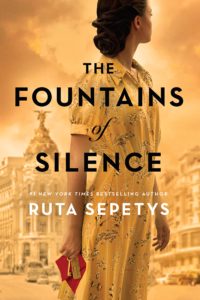 Begun in 2012, Ruta Sepetys’s fourth YA novel, The Fountains of Silence, has emerged at a particularly fraught moment, one that has given this “hidden history” outsized significance. The history in question involves more than 300,000 infants and children taken from poor and/or politically suspect families and sold abroad or to supporters of Generalíssimo (Supreme General) Francisco Franco immediately after the fascists’ victory in the Spanish Civil War and in the three decades that followed. As far-right religious leaders such as Robert Jeffress threaten a second Civil War in the United States and thousands of undocumented migrant children have been separated from their parents at the border and are now unaccounted for, The Fountains of Silence has gone beyond a meticulously researched, atmospheric YA novel to a must-read by teens and adults alike as we search the past for insights into our experiences today.
Begun in 2012, Ruta Sepetys’s fourth YA novel, The Fountains of Silence, has emerged at a particularly fraught moment, one that has given this “hidden history” outsized significance. The history in question involves more than 300,000 infants and children taken from poor and/or politically suspect families and sold abroad or to supporters of Generalíssimo (Supreme General) Francisco Franco immediately after the fascists’ victory in the Spanish Civil War and in the three decades that followed. As far-right religious leaders such as Robert Jeffress threaten a second Civil War in the United States and thousands of undocumented migrant children have been separated from their parents at the border and are now unaccounted for, The Fountains of Silence has gone beyond a meticulously researched, atmospheric YA novel to a must-read by teens and adults alike as we search the past for insights into our experiences today.
The son of a Texas oilman and a mother born in Spain, 18-year-old Daniel Matheson travels with his parents to Madrid in 1957, where his father seeks to close a business deal with the dictator and his mother is recovering from an unknown tragedy. Against his father’s wishes that he join the oil business, Daniel dreams of becoming a photojournalist. He hopes the pictures he takes in Spain will earn him a college scholarship so he can break away from his family and follow his dream. However, his idealism and journalistic instincts spell trouble in a country where people have no freedom. On his first day, he gets into trouble with the police for photographing a nun carrying a dead baby. His attraction to the young hotel housekeeper portends more trouble, as Ana and her orphaned siblings are suspect due to their parents’ left-wing sympathies.
Through short chapters narrated from multiple points of view – Daniel’s, Ana’s, Ana’s two siblings, and her cousin Puri, a government supporter and devout Catholic who works at an orphanage and stumbles onto the baby-stealing scheme – Sepetys offers snapshots of life under an all-powerful and cruel dictatorship. An outsider, Daniel is a compelling, sympathetic character in whom readers may recognize their own idealism and unawareness of what life is like in unfree corners of the world. Through Ana and her siblings, Sepetys explores once again, as she did in Between Shades of Gray and Salt to the Sea, how those crushed by forces greater than themselves come to survive and save those they love. Through Puri, she shows a naïve, complacent follower coming to question her world and her own life story. When the priest at Confession tells her, “We owe it to our children and our future to protect Catholic values and morals,” she asks, “So that means…is it better to be raised by the right parents, even if they are not the birth parents?” and, “is it better for a child to have no parents than the wrong parents?” (p. 264)
Though published as YA, The Fountains of Silence has been marketed as a crossover title and has already made its way into adult book clubs. Rich in historical detail and intrigue, it is an engrossing read that has become more relevant (unfortunately) with each day and each new headline.
1 comment for “Civil War, Then Secrets: A Review of The Fountains of Silence”